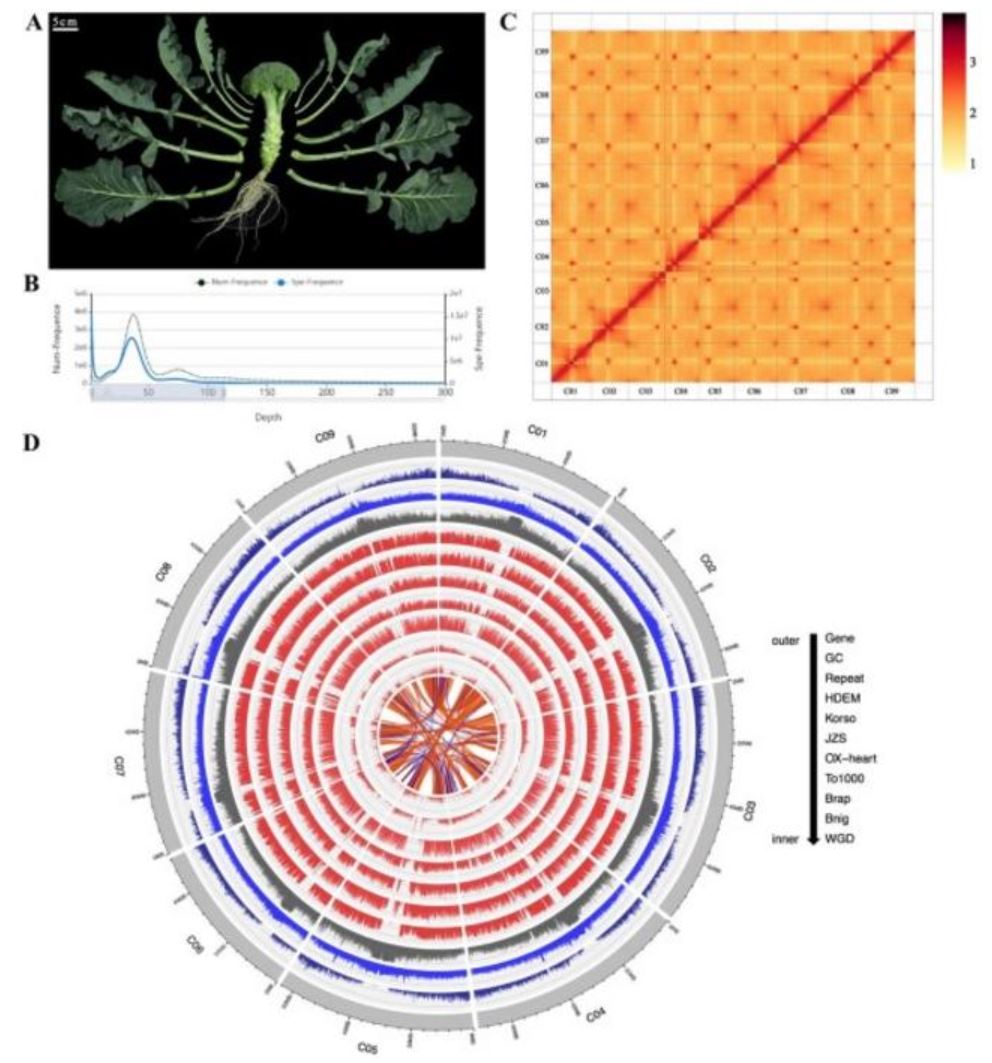June 21, 2024

Genome of B. oleracea var. italica Plenck (Bop04-28-6, broccoli). A Image showing key features of a mature period broccoli. B 17-mer spectrum of Illumina reads. C Hi-C interaction heat map of the assembled Bop04-28-6 genome. Color bar at the right represents the density of Hi-C interactions, which is indicated by the number of links at 1-Mb resolution. D Circos display of Bop04-28-6 and other species genomic features. - Credit: Horticulture Research
A detailed genomic study of broccoli has revealed the genetic foundations for the production of glucosinolates (GSLs), compounds celebrated for their health benefits, including anti-carcinogenic properties. By assembling a high-quality chromosome-level genome, researchers identified key genes involved in GSL biosynthesis. These findings offer critical insights for future genetic studies and the development of Brassica crops with enhanced nutritional value, paving the way for improved health benefits from these widely consumed vegetables.
Broccoli is renowned for its health benefits, primarily due to its rich glucosinolate (GSL) content, which has anti-carcinogenic and antioxidant properties. Despite extensive studies on Brassica species, the genetic basis for GSL diversity remains unclear. Understanding these mechanisms is crucial for enhancing the nutritional value of broccoli and related crops. Previous research has identified various GSL structures, but the specific genes and their roles in GSL biosynthesis need further exploration. Addressing these gaps is essential for developing genetically improved Brassica crops with enhanced health benefits.
Researchers from Hunan Agricultural University have published a study (DOI: 10.1093/hr/uhae063) on February 28, 2024, in Horticulture Research, presenting a chromosome-scale genome assembly of broccoli. This study utilizes advanced sequencing technologies to provide a detailed analysis of GSL biosynthesis.
The study successfully assembled a high-quality chromosome-scale genome of broccoli using advanced PacBio HiFi reads and Hi-C technology, achieving a total genome size of 613.79 Mb and a contig N50 of 14.70 Mb. This detailed genomic map allowed the identification of key genes involved in GSL biosynthesis, including the crucial methylthioalkylmalate synthase 1 (MAM1) gene. The research demonstrated that overexpression of BoMAM1 in broccoli significantly increases the accumulation of C4-GSLs, highlighting its vital role in GSL biosynthesis. Additionally, the study provided insights into the evolutionary mechanisms that contribute to the diversity of GSL profiles among different Brassica species. These findings offer a comprehensive understanding of the genetic factors influencing GSL production, which is essential for future genetic studies and the development of Brassica crops with enhanced nutritional properties.
Dr. Junwei Wang, a corresponding author of the study, stated, "Our findings provide a comprehensive understanding of the genetic factors influencing GSL biosynthesis in broccoli. This knowledge is crucial for future genetic improvement and enhancing the nutritional value of Brassica crops."
This genomic study offers valuable resources for molecular breeding programs aimed at improving the nutritional content of broccoli and other Brassica crops. By understanding the genetic basis of GSL biosynthesis, researchers can develop varieties with enhanced health benefits, contributing to better human health and nutrition.
References
Article: Chromosome-scale reference genome of broccoli (Brassica oleracea var. italica Plenck) provides insights into glucosinolate biosynthesisDOI: 10.1093/hr/uhae063
Original Source URL: https://doi.org/10.1093/hr/uhae063
Funding information
This work was supported by the National Key Research and Development Program of China (2022YFF1003000), the National Natural Science Foundation of China (32372682, 32272747, 32072585, 32072568), the International Cooperation Projects of National Key R&D Program of China (2022YFE0108300), the Graduate Research Innovation Project of Hunan (2023XC103), and the innovation and entrepreneurship training program for college students (S202310537006X).
About Horticulture Research
Horticulture Research is an open access journal of Nanjing Agricultural University and ranked number one in the Horticulture category of the Journal Citation Reports ™ from Clarivate, 2022. The journal is committed to publishing original research articles, reviews, perspectives, comments, correspondence articles and letters to the editor related to all major horticultural plants and disciplines, including biotechnology, breeding, cellular and molecular biology, evolution, genetics, inter-species interactions, physiology, and the origination and domestication of crops.